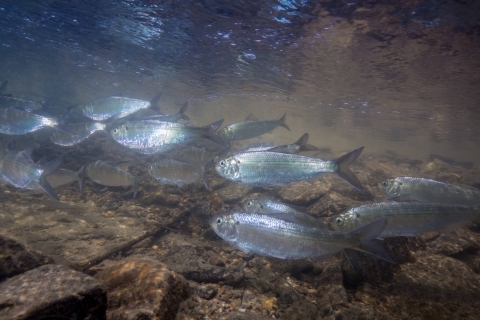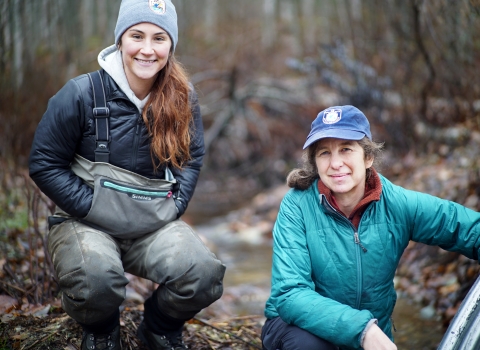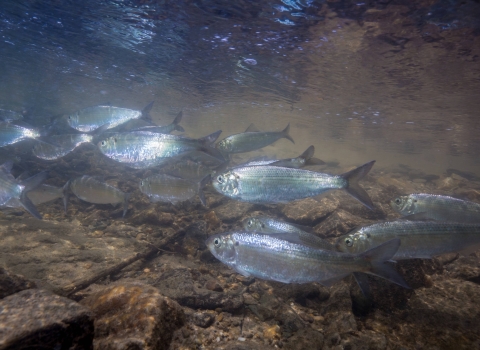Fish passage is the ability of fish or other aquatic species to move through an aquatic system among all habitats necessary to complete their life cycle. The National Fish Passage Program opens up aquatic travel routes that have been blocked or fragmented.
When rivers are fragmented by dams, culverts, or other diversions, they can become congested. These aquatic barriers have the same effect as roadblocks on a busy highway. Traffic backs up, people get stranded, and emergency services stall out.
The added congestion on the system puts everyone at risk. But unlike roadblocks that can often be avoided, fish can’t simply take a detour when their swimways are blocked. Instead, they become separated from their breeding grounds, cut off from food sources, or trapped in unsafe waters.
The rivers, streams, and coastal systems of North America once supported vast annual runs Pacific salmon, American shad, blueback herring, Pacific lamprey and American eel.
These species and many others, including some at-risk and listed species, depend on connected streams and high-quality habitat to survive. During the past 200 years, many of these populations of fish have decreased drastically, in large part due to the proliferation of barriers like dams, undersized culverts, and watershed development that blocks fish from their natural migrations.
The National Fish Passage Program helps by finding blockages and either removing them or creating a detour that fish can use.
Today, millions of obsolete or poorly designed dams, roads, and levees in the U.S. keep fish, and other aquatic species from moving freely to feed, migrate, and reproduce. These fish passage fish passage
Fish passage is the ability of fish or other aquatic species to move freely throughout their life to find food, reproduce, and complete their natural migration cycles. Millions of barriers to fish passage across the country are fragmenting habitat and leading to species declines. The U.S. Fish and Wildlife Service's National Fish Passage Program is working to reconnect watersheds to benefit both wildlife and people.
Learn more about fish passage barriers not only fragment aquatic habitats, they are also often more susceptible to impacts from climate change climate change
Climate change includes both global warming driven by human-induced emissions of greenhouse gases and the resulting large-scale shifts in weather patterns. Though there have been previous periods of climatic change, since the mid-20th century humans have had an unprecedented impact on Earth's climate system and caused change on a global scale.
Learn more about climate change putting communities at risk. By removing obsolete and dangerous infrastructure fish passage projects also eliminate public safety hazards, improve climate resilience and restore river ecosystems.
What is a barrier?
A barrier is anything that prevents or reduces the ability of aquatic species to move where needed to survive and complete their life cycle. This includes physical barriers, such as dams, culverts, and levees, and environmental barriers such as excess sediment, poor water quality, and temperature or flow variations.
Types of barriers:
Culverts are structures that allow water to flow under a road, railroad, trail, or similar waterway obstruction. An undersized or improperly placed culvert can impede or totally block fish and aquatic species from passing.
Dams are physical structures running the width of a river system to capture or impound water. Some fish species are very poor jumpers and cannot get past even low height dams.
Levees are typically constructed earthen low ridges or embankments along the edges of a stream or river that impede flooding of adjacent land. Levees often cut off access to wetland areas that are critical to aquatic species.
Increased sediment in waterways changes the habitat and structure of the area and can result in the habitat becoming unpassable for an aquatic species. Increased suspended sediment in a waterway can also affect species’ ability to pass through an area.
Abnormal increases or decreases in water temperature can prevent movement of fish. Aquatic species are sensitive to changes and extremes in temperatures.
Water diversions are structures that redirect water from a stream for another purpose, such as agricultural use. These structures can be harmful to fish if the fish are redirected along with the water onto the agricultural lands or if the fish become caught on the water intake structure.
High velocities or lack of water flow can be a barrier to fish passage.
Poor water quality can prevent fish from being able to survive in or migrate through an area. Many aquatic species are sensitive to poor water quality conditions, such as low oxygen levels or high levels of contaminants.
The National Fish Passage Program works with local communities on a voluntary basis to remove barriers and restore rivers for the benefit both fish and people.
Get started planning a project with us.
The National Fish Passage Program combines expertise in fish migration and biology with specialized engineering experience. A network of regional coordinators assists communities, Tribes, and private landowners with projects on small creeks, big dams, and everything in between. Fish passage project proposals can be initiated by any individual, organization, government, or agency. However, proposals must be submitted and completed in cooperation with a Fish and Wildlife Conservation Office.







